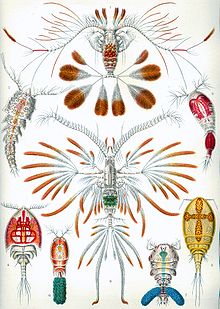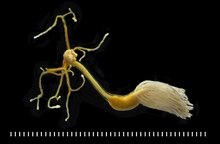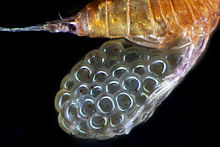Copepods
| Copepods | ||||||||||||
|---|---|---|---|---|---|---|---|---|---|---|---|---|

Eudiaptomus vulgaris in lateral view |
||||||||||||
| Systematics | ||||||||||||
|
||||||||||||
| Scientific name | ||||||||||||
| Copepoda | ||||||||||||
| Milne Edwards , 1840 |
Copepods (Copepoda) are small crustaceans (Crustacea) that colonize marine and limnic waters. With around 13,000 morpho species, they form the most species-rich group of crustaceans and represent the largest proportion of marine zooplankton . They are therefore a very important element of the marine food chain . They live as filter feeders, predators or parasites. In the latter, a strongly modified morphology can occur due to the way of life.
morphology
The body length is mainly between 0.2 and 2 mm. The smallest species, Sphaeronellopsis monothrix (male 0.11 mm), lives in the brood chamber of ostracods (Ostracoda). The largest species, Pennella balaenoptera , a parasite on baleen whales, reaches a body length of 320 mm. The original body shape is elongated to teardrop-shaped, but is greatly modified within the group depending on the lifestyle. Pelagic species still correspond to the original blueprint. Ground dwellers are more flattened and species burrowing in the substrate are more cylindrical. The most modified are parasitic species in which the adult females can hardly be recognized as copepods and whose membership of copepods can only be determined on the basis of the stages of development.
The body is made up of the head, ten trunk segments and the telson . The head and 1st thoracic segment are always fused. A carapace is missing. The trunk is divided into six thoracic segments with limbs and four abdominal segments, which are connected by the main body joint. The 1st thoracopods are converted to single-branch maxillipedas. The following 4 pairs are two-branch swimming legs. The sixth and last pair is often reduced or one-branch. The genital opening is on the 1st abdominal segment, where one or two egg sacs are attached in the female. The antennae is designed according to the way of life. In the Calanoida it is significantly longer than, in contrast , in the Cyclopoida it is shorter than half the body length. The furcal branches standing at the telson serve as levitation extensions or control organs. The shape of the mandibles and the vestibule reflect the way of life and are important taxonomic features. In the Siphonostomatoida, the labrum and labium are fused into a cone and sometimes drawn out into a long suction tube. The color of the Copepoda is based on stored oil droplets that serve as reserve fat. Own skin pigments rarely play a role.
Distribution and occurrence
The Copepoda are cosmopolitan and inhabit all types of water on earth, from the oceans to the smallest bodies of water. They are only absent in areas covered by permanent ice and in waterless areas. Their main distribution is around 80% of the recent species in the sea, where they occur with the greatest number of individuals and species in the upper layers and in the littoral. Copepoda have been detected to a depth of 5000 m. The populated habitats are extremely diverse. In principle, a distinction can be made between freely swimming, on the ground, burrowing in the substrate and parasitic species. Moist mosses and leaf axils are also colonized on land. Some species have also invaded the groundwater.
Very old lakes in particular are biodiversity hotspots . Of the 120 species found in Lake Baikal , most are endemic . The same applies to Lake Tanganyika .
Way of life
development
The grooving of the eggs is usually holoblastic in equal parts (totally adequate), sometimes also in unequal parts (inadequate). Some parasites seem to furrow on a purely superficial basis . Nauplius larvae almost always hatch from the egg . Various parasites are an exception because they have a shortened development cycle and a larva in the copepodite stage hatches. The young animals usually go through six stages as nauplius larvae, with molting at each stage. The animals also continue to molt in the six Copepodit stages, with the number of segments and pairs of legs increasing. The 12th stage, the sixth stage of the copepodite, is the adult , which no longer sheds its skin. The service life is strongly dependent on the temperature. The lifespan of the mussel parasite Mytilicola intestinalis is 3–6 months in the Mediterranean, with several overlapping generations forming within one year. In the cooler waters of England's southwest coast, only two generations appear during the summer. The individuals here reach an age of 9–12 months. For larger species such as Eudiaptomus vulgaris 10–13 months are given, for Megacyclops viridis 8–14 months. Many species form permanent eggs as a survival strategy during unfavorable seasons, especially winter. However, a few species form cysts as adults and are mainly active in winter. They survive the summer in the cysts.
Reproduction
All Copepoda are sexually separated and show a pronounced sexual dimorphism . The males are always smaller than the females and the antennae is designed as a grasping organ. The other head limbs and thoracopods can also be different. The sex ratio is clearly shifted in favor of the females in many species. In some species no males have been found at all, which is probably due to the rapid death after fertilization. Parthenogenesis only occurs in a few species. Mating has been well studied in the Calanoida . The male grabs the female by the furcal branches with his kneeling antenna (usually the right one) . The male turns around so that the heads are facing in opposite directions. The abdomen of the female is grasped with the right 6th thoracopod and a spermatophore is attached to the abdomen with the left 6th thoracopod . When the eggs are laid, ice sacs are created that attach to the genital segment. The eggs remain there until the nauplius larvae hatch .
nutrition
The Copepoda have a very varied diet, according to their individual ways of life. However, all diets can be derived from a predatory one. There are filter feeders or species that can also actively grab individual, small food particles. However, many species can do both. Herbivorous species can filter algae down to a size of 5 µm. Carnivorous species filter animals smaller than 30–50 µm, larger ones are actively captured. In the case of commensals and parasites, the spectrum ranges from simple waste recyclers to stationary bloodsuckers. The filter feeders use detritus and the entire spectrum of phytoplankton , whereby certain species, depending on ecological conditions, select the food very specifically. The predators take whatever prey they can overwhelm. These are, for example, caseless Protozoa , other Copepoda up to fry. Ecto- or endoparasites feed on scraps of skin and mucus or on the ingested blood fluid.
ecology
The Copepoda are probably the most individual group of the Metazoa on earth. In the upper layers of almost all ocean surfaces, they make up 90% of all zooplankton. Since they sometimes occur in dense schools (around 10,000 individuals per m³ for Pseudocalanus species), they play a crucial role in the nutrition of many commercially used fish. Copepods are also the most important food source for fish in freshwater. On the other hand, carnivorous Copepoda can also cause damage to fish fry in fresh water. The food chain is very short as many copepoda feed on phytoplankton and then are consumed directly by fish. Dead copepoda decompose very quickly. With a water temperature of 22 ° C, this happens in three days.
Systematics
The following autapomorphies apply to the taxon
- Absence of complex eyes during all stages of development
- Cephalothorax (fusion of the cephalon and 1st thoracic segment)
- Intercoxal plate (median connection between the coxae of a segment)
- Antenna 1 is designed as a grasping organ in males
- Formation of spermatophores
- Seed bag
- Formation of egg sacs through glandular septa of the fallopian tubes
Internal system
The copepods represent a subclass in the classification of crustaceans (Crustacea). Huys & Boxshall originally differentiated 10 orders, whereby the division into taxa of the same rank is problematic at the order level. The inclusion of the order Poecilostomatoida in the Cyclopoida, which was proposed in 2004, has not been accepted. This results in the following 10 orders for the internal system:
- Platycopioida
- Calanoida
- Mormonilloida
- Siphonostomatoida
- Misophrioida
- Cyclopoida
- Poecilostomatoida
- Monstrilloida
- Harpacticoida
- Gelyelloida
According to Huys & Boxshall, the relationships result in the following cladogram:
| Copepods (Copepoda) |
|
||||||||||||||||||||||||||||||||||||||||||||||||
|
|
Sources and further information
literature
The article is mainly based on the following documents:
- Hans Eckard Gruner: Textbook of special zoology: Arthropoda (without Insecta) . Vol. 1, part 4. Gustav Fischer, Stuttgart / Jena, 1993
- Rony Huys, Geoffrey Boxing Hall : Copepod Evolution . The Ray Society, London, 1991
- Gregor Christoph Schwartze: Micro-range analysis of marine biomineralization products: Copepods of the Southern Ocean and the North Sea . Grin Verlag, Munich, 2011, ISBN 978-3640854387
Individual evidence
- ↑ Boxshall, GA & TD Evstigneeva, 1994. The evolution of species flocks of copepods in Lake Baikal: a preliminary analysis. In: Martens, K., B. Goddeeris & G. Coulter (eds), Speciation in Ancient Lakes. Archives for Hydrobiology, Result Limnology 44: 235–245.
- ↑ Peter Ax: The System of Metazoa II. A textbook on the phylogenetic system, Gustav Fischer, Stuttgart / Jena, 1999.
- ^ Geoff A. Boxshall , SH Halsey: An Introduction to Copepod Diversity . The Ray Society, London, 2004.



